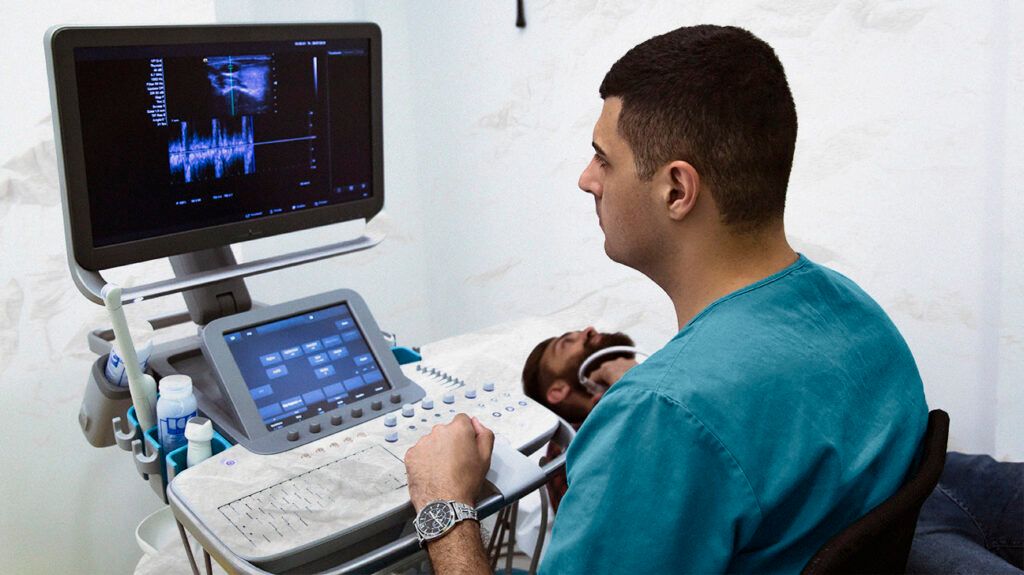The signs that thyroid cancer has spread can vary depending on where in the body it has traveled to. Thyroid cancers often spread to the nearby lymph nodes and the lungs, bone, brain, and liver.
For all types of thyroid cancer, early detection and personalized treatment plans are crucial for improving outcomes.
Advances in targeted therapies and genetic testing are providing new hope for people with thyroid cancer, even in more advanced stages of disease.
This article looks at what to know about metastatic thyroid cancer.

It is rare for thyroid cancer to spread beyond the neck. This occurs in
The spread of thyroid cancer can cause various signs and symptoms, depending on which area of the body it is affecting.
Thyroid cancer
General signs of metastasis (spread)
- unexplained weight loss
- fatigue or weakness
- pain
- shortness of breath
Lymph nodes
When thyroid cancer spreads to the lymph nodes — which is
One possible symptom is swollen lymph nodes in the neck. A person may feel lumps when touching the neck area. This swelling might not be painful.
The spread of thyroid cancer to lymph nodes can sometimes cause difficulties with swallowing or breathing if the enlarged nodes press against the esophagus or trachea.
Lungs
Metastasis in the lungs can lead to respiratory symptoms
- a cough that does not go away
- shortness of breath
- hemoptysis (coughing up blood)
- chest pain
- weight loss
- loss of appetite
- fluid around the lungs
Bones
Thyroid cancer can spread to any bone in the body but
Signs and symptoms of bone metastasis
- pain in the affected bone, which can become more severe or persistent over time
- an increased risk of fractures, even with minor injuries
- reduced mobility due to pain or bone weakness
Brain
Symptoms of brain metastasis vary and depend on the affected part of the brain.
Common symptoms
- headaches
- seizures
- nausea or vomiting
- sleepiness
- changes in emotions
- problems with hearing, swallowing, or vision
- changes in mental status, such as confusion or memory issues
- difficulty speaking
- weakness or numbness in parts of the body, which can indicate neurological impairment
Liver
Liver metastasis in thyroid cancer is
Symptoms
- abdominal pain or discomfort, particularly in the upper right side
- jaundice (a yellowing of the skin and eyes)
- fatigue
- unexplained weight loss
These symptoms occur because the presence of cancer cells makes it difficult for the liver to perform its usual functions.
When papillary thyroid cancer spreads, it
Outlook
The
| Stage | Survival rate |
|---|---|
| local | more than 99.5% |
| regional | 99% |
| distant | 74% |
Follicular thyroid cancer is
This spread can make it more challenging to treat.
Outlook
The 5-year relative survival rates for follicular cancer are
| Stage | Survival rate |
|---|---|
| local | more than 99.5% |
| regional | 98% |
| distant | 67% |
A person can have medullary thyroid cancer (MTC) for a long time without symptoms due to the small size of the tumor. However, if the tumor blocks the vocal cords, it can cause a hoarse voice. And if it blocks the windpipe, it can cause difficulty breathing.
MTC can spread to bones as well as the lungs, liver, brain, and other organs.
Outlook
The
| Stage | Survival rate |
|---|---|
| local | more than 99.5% |
| regional | 92% |
| distant | 43% |
Anaplastic thyroid cancer is a rare and aggressive form of thyroid cancer, accounting for
Due to its aggressive nature, symptoms can progress quickly, and it may be resistant to traditional thyroid cancer treatments.
Outlook
The outlook for anaplastic thyroid cancer is
| Stage | Survival rate |
|---|---|
| local | 39% |
| regional | 11% |
| distant | 4% |
How long can thyroid cancer go undetected or before symptoms show?
The length of time thyroid cancer can go undetected varies depending on factors such as the type of thyroid cancer and how quickly it grows.
For example, papillary thyroid cancer, the most common type, often grows very slowly and can remain asymptomatic for a long time. Other types, such as anaplastic thyroid cancer, are much more aggressive and cause symptoms quickly.
However, the
Where is the first place thyroid cancer spreads?
The first place thyroid cancer spreads can depend on the type.
For example, papillary thyroid cancer often spreads to the nearby lymph nodes first. Anaplastic thyroid cancer spreads to the neck and then to distant parts of the body. Follicular thyroid cancer spreads to the lungs and bones.
How long does it take thyroid cancer to spread?
The time it takes for thyroid cancer to spread
Papillary and follicular thyroid cancers may spread slowly over several years, particularly in their movement to distant organs.
Medullary thyroid cancer’s spread can be more variable, sometimes occurring relatively quickly.
Anaplastic thyroid cancer is known for its rapid progression, often spreading quickly to distant organs.
The signs that thyroid cancer has spread can depend on what area of the body the cancer is affecting. General signs that thyroid cancer has spread to other parts of the body include fatigue, shortness of breath, unexplained weight loss, and pain.
Although this can vary by type, thyroid cancer often spreads to the nearby lymph nodes, the brain, the lungs, the liver, and the bones.
